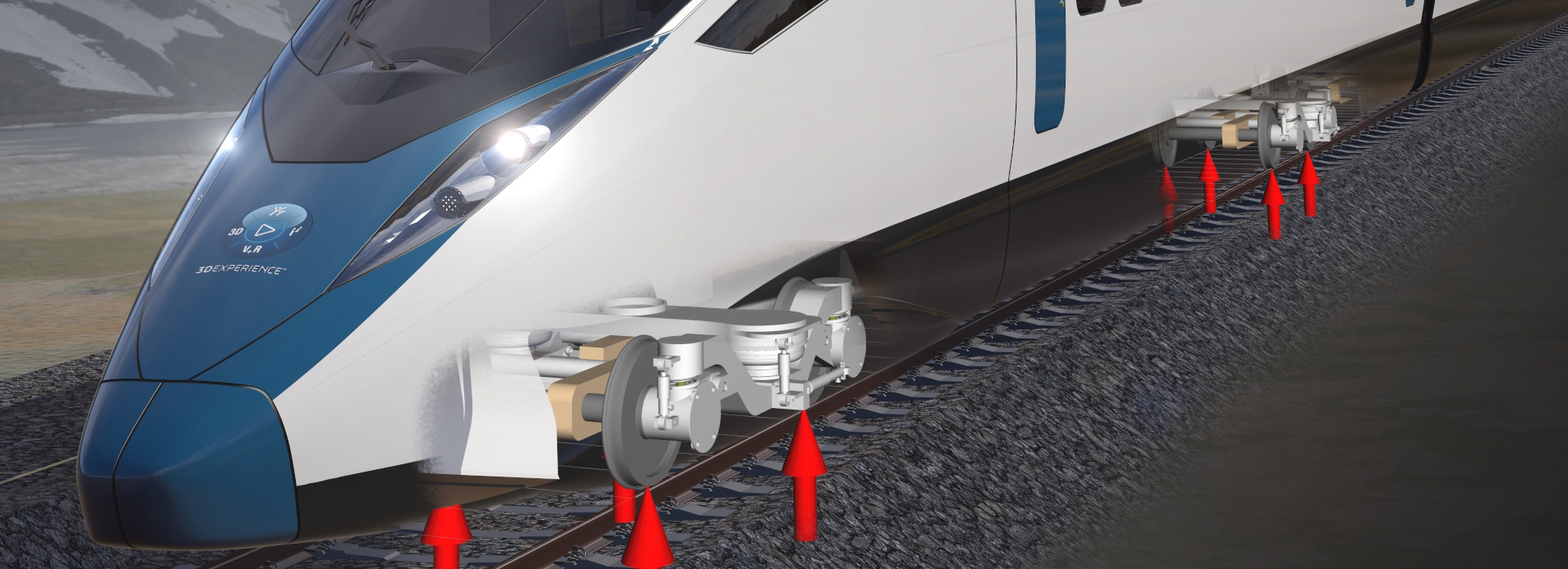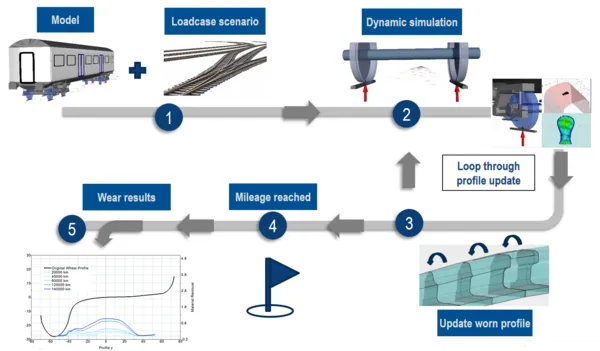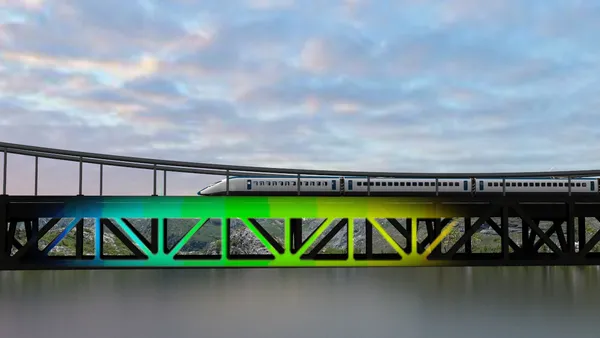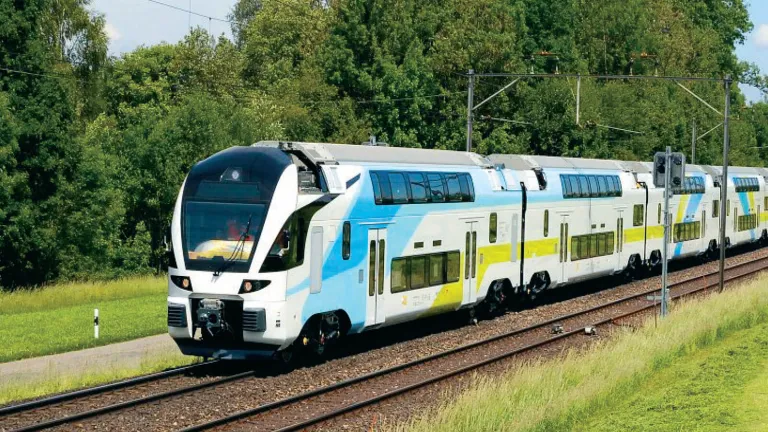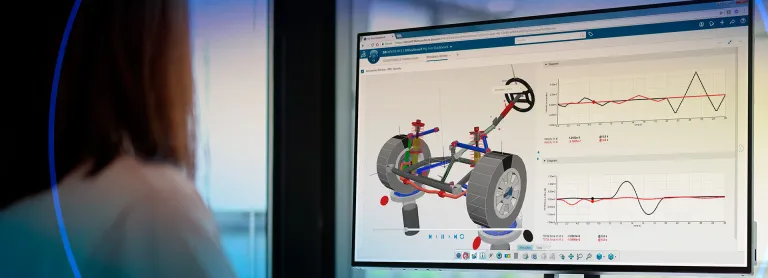Rail Vehicle Dynamics Simulation
Understanding and Optimizing Rail-Guided Systems
Simulate Trains and Railway Dynamics
Understanding Rail Vehicle Dynamics through MBS
Rail vehicles are complex systems and their performance is determined by the interaction of multiple components, including the rail-wheel-contact interface, suspension, bogies, couplings and other moving parts. Optimizing and understanding these interactions is essential to ensuring vehicle safety, speed, reliability and comfort. The complexity and sheer length of trains makes simulating their running dynamics a challenging engineering problem to solve. Engineers must account for all possible relative motions between the individual components.
Multibody System Simulation (MBS) is the only technology making it possible to analyze and understand the complete system dynamics, without requiring a physical prototype. MBS enables engineers to build up a virtual prototype, allowing virtual testing early in the development cycle. A thorough exploration of the design space can be conducted, considering numerous KPIs, to find the optimum design between competing alternatives, faster and cheaper than physical tests. The value of MBS continues into the service life of the vehicle, through (but not limited to) simulation-aided maintenance, accident investigations, and warranty/misuse case investigation.
Wheel-Rail Contact Mechanics and Their Impact
The wheel-rail contact is the most influential characteristic on the overall dynamic behavior of a rail vehicle. This contact plays a role in almost all the high-level challenges of the railway industry including:
- Safety and reliability of operation: vehicle derailment stability on the tracks.
- Passenger comfort: Track irregularities excite the vehicle through the contact interface.
- Maintenance costs, radiated noise and energy efficiency: all are influenced by the wear of rail and wheel surfaces.
Due to the high stiffness metal-to-metal contact, and the complex friction behavior between the surfaces, wheel-rail contact mechanics are difficult to solve. To correctly simulate the rail-vehicle dynamics, an accurate rail-wheel contact calculation is essential. Simpack technology offers fast, accurate and robust rail-wheel contact algorithms, allowing non-elliptical contact and multiple contact patches per wheel.
Optimizing Performance with Virtual Prototyping
This video gives a high-level overview to develop, optimize and virtually validate the dynamics and performance attributes for rail vehicles using simulation capabilities of Dassault Systèmes. It focuses on multiple aspects like providing a safer and comfortable journey, reducing the traveling time, predicting tolerances from arbitrary structures and providing predictive maintenance information.
MBS Applications for all types of rail system
Multibody system simulation (MBS) can be used for the analysis and design of any type of rail-based/guided vehicle or mechanism, from tram cars to complete articulated high-speed trains. It can also be used for specialist applications such as roller coasters, material handling systems and even magnetically levitated trains. Used worldwide by manufacturers and operators, Simpack is the leading MBS software for railway system dynamics.
Typical applications include:
- Derailment safety
- Curving and on-track simulations
- Critical speed
- Passenger comfort
- Profile and track optimization, wear and rail-contact-fatigue
- Gauging
- Driveline and braking
- Switches and crossings
- Virtual homologation (Certification by simulation)
- Suspension modeling
Railway Maintenance through Simulation-Aided Wear Analysis
- Analysis of wheel and rail wear
- Flexible Track Simulation
Analysis of wheel and rail wear
Every year in the EU alone, more than 20 billion euros are spent on railway maintenance and renewal, representing more than 50% of total expenditure on railway operations and infrastructure (Seventh Rail Market Monitoring Report, European Commission). Simulation-aided maintenance has the potential to decrease this expenditure by reducing the down time due to unplanned maintenance issues, enabling smart maintenance focusing on only critical track sections that require it. Simulation can be used to identify critical track sections and critical vehicle parts, allowing operators to plan maintenance schedules accordingly with the potential to significantly reduce maintenance costs.
Wheels and rails are subject to wear and rolling contact fatigue (RCF) throughout their lifecycle, leading to maintenance and safety issues. Multi-body-simulation can form part of a simulation-aided maintenance approach, determining the wear distribution across the rail and wheel profiles and the change in profile due to wear. Since there are many different wear and RCF models, Simpack has an open structure, allowing the implementation of user-defined wear and RCF laws.
APPLICATIONS
- Simulation of wheel wear, rail wear, and RCF
- Comparison of vehicle concepts and profile geometries concerning wear and RCF
Flexible Track Simulation
The flexibility of the track and track structure can have a strong influence on the dynamic characteristics of a rail vehicle. With track such as ballasted track or diverging crossings with flexible blade rails, not only is the vehicle reacting dynamically to the track, but the track is also dynamically reacting to the vehicle. Including the flexibility of the track enables the observation of the coupled dynamic reactions of both a rail vehicle and the track due to the material flexibility. This could be at any scale, from the deflection of a switch blade rail as a vehicle passes over it, to the vibrations through an entire bridge. In addition, loads through a track section can be evaluated and exported to a finite element code for structural analysis, or to a dedicated software for fatigue and durability analysis.
Simpack technology enables the modeling of finite element-based flexible track sections, allowing investigation of advanced train/track interaction. Multiple flexible track sections can be modeled simultaneously, allowing the dynamic behavior of almost any track structure to be analyzed. Two modeling variations are available, covering all fidelity levels. The standard method covers linear deformation, offering a quick workflow with fast calculation times, allowing the accurate calculation even of complete complex structures such as bridges. The higher fidelity method is used to represent the track and ballast compliance, with geometric nonlinearity effects such as a coupling between vertical and lateral flexibility of tracks included.
Flexible track simulation is used for the dynamic analysis of:
- Sleeper foundations
- Rail joints
- Rail pads
- Hanging sleepers
- Coupled effects of leading and trailing wheelsets
- Loads within track structure
- Switches and crossings
- Bridges
Start Your Journey
Explore the technological advancements, innovative methodologies, and evolving industry demands that are reshaping the world of Rail Vehicle Dynamics Simulation. Stay a step ahead with SIMULIA. Discover now.
FAQs about Rail Vehicle Dynamics Simulation
Also Discover
Learn What SIMULIA Can Do for You
Speak with a SIMULIA expert to learn how our solutions enable seamless collaboration and sustainable innovation at organizations of every size.
Get Started
Courses and classes are available for students, academia, professionals and companies. Find the right SIMULIA training for you.
Get Help
Find information on software & hardware certification, software downloads, user documentation, support contact and services offering
